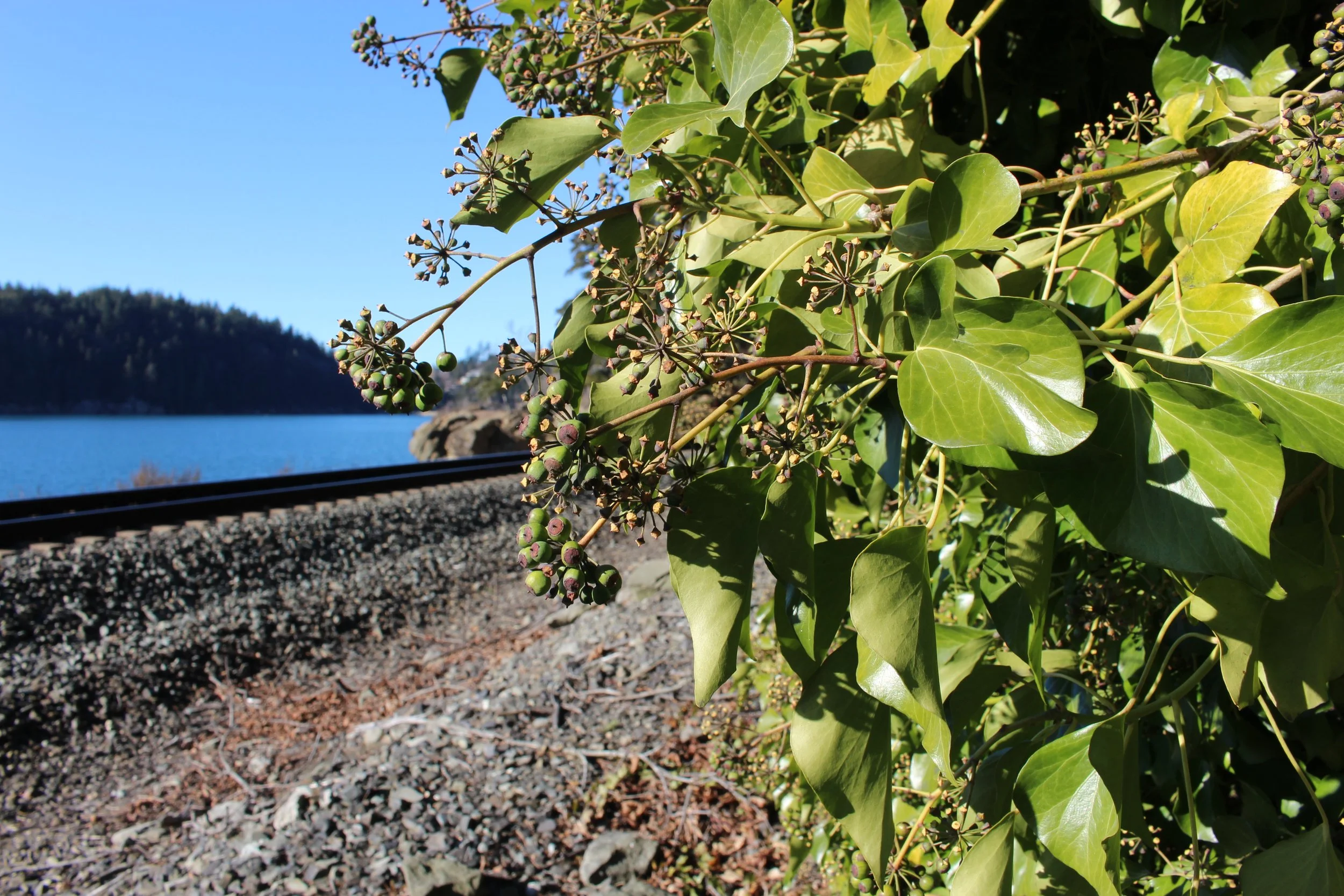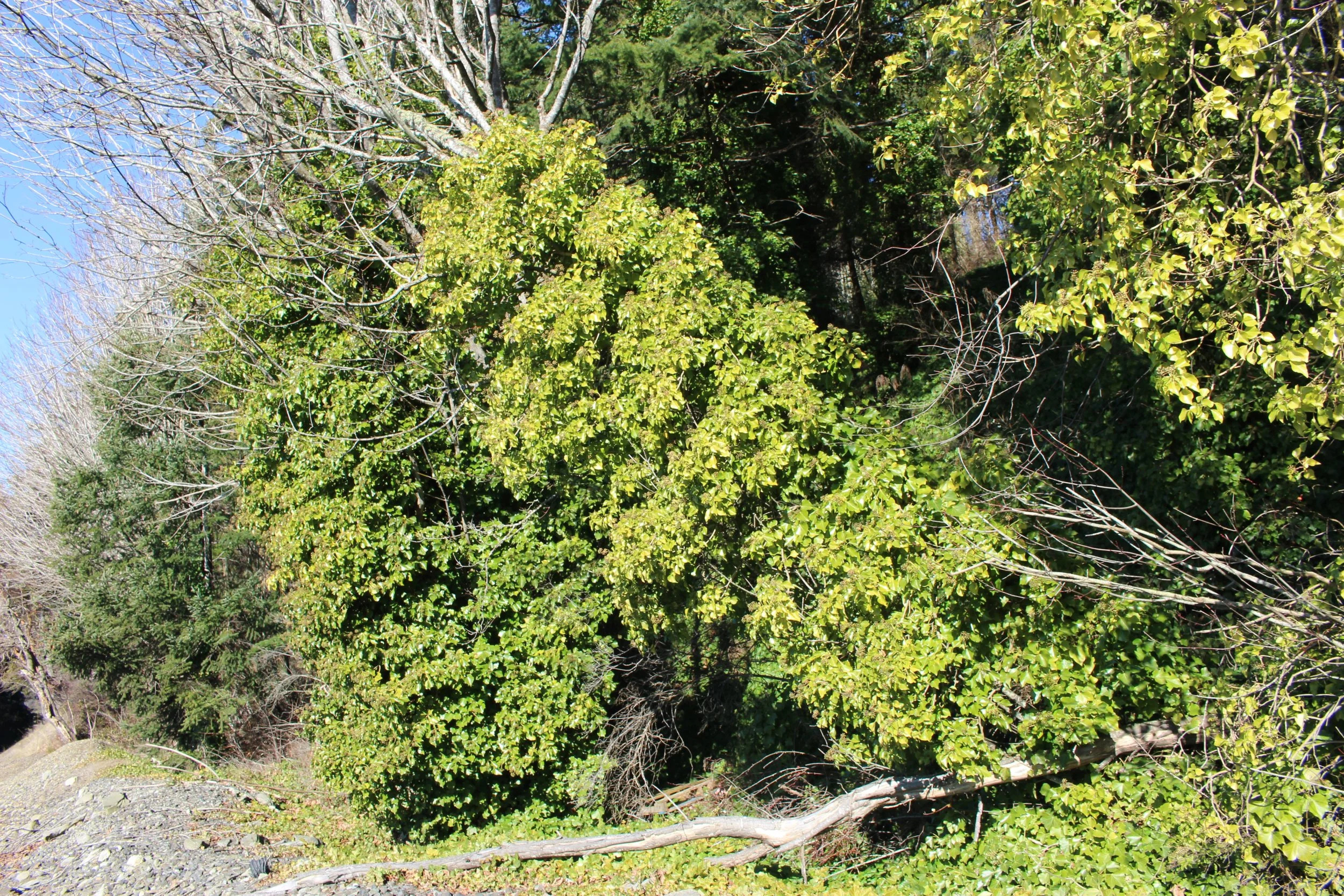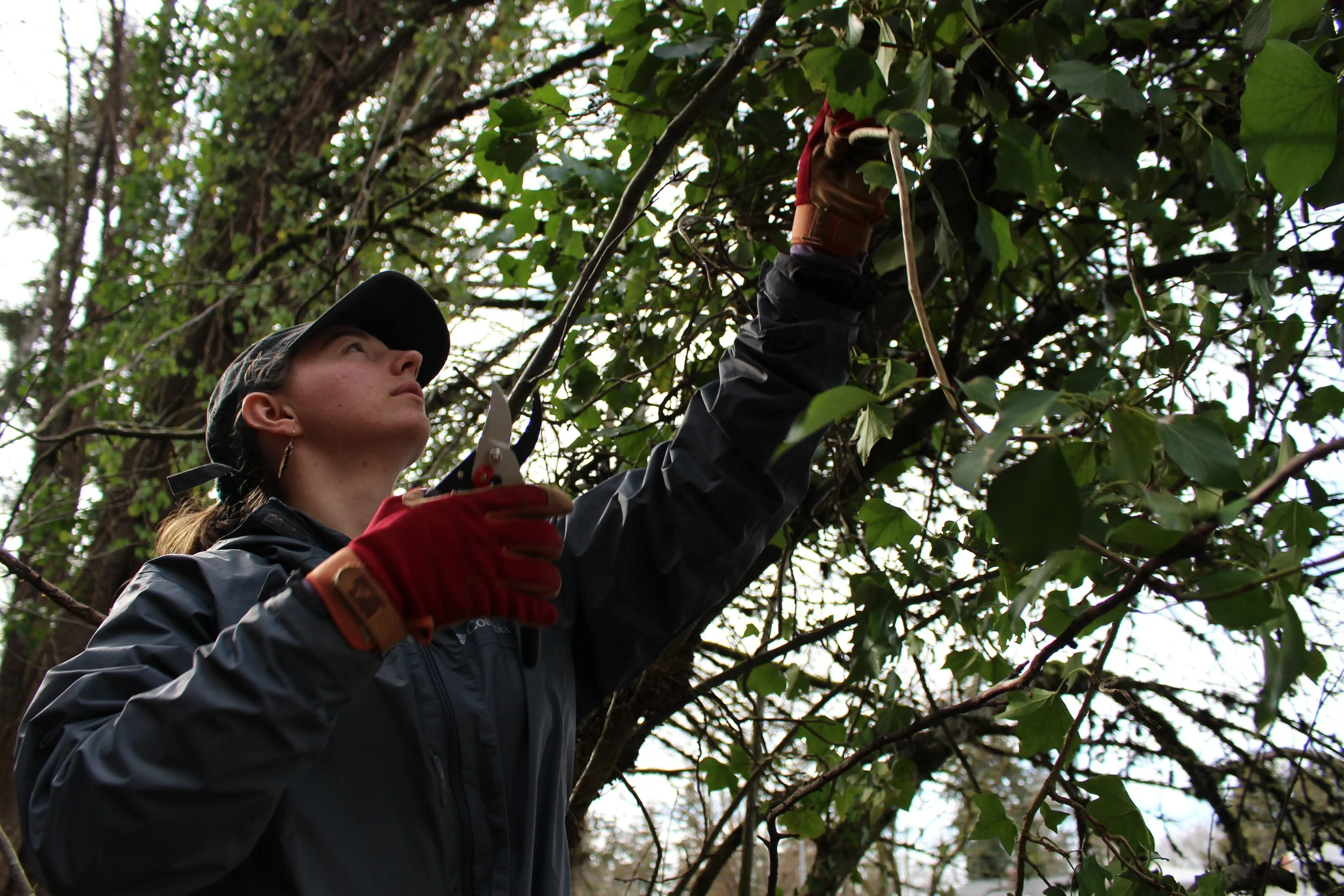Class C Noxious Weed, Class A Annoyance. What’s our Plan B?
How organizations across Whatcom County are eliminating a beautiful but silent tree killer.
Mature English ivy leaves, flowers, and unripened berries near Teddy Bear Cove. // Photo by Fallon Jenkins
Story by Fallon Jenkins
April 1, 2025
Michael Feerer working to remove English ivy at Railroad Trail. // Photo by Mallorey Roe
As Michael Feerer gazed out of his window, his eyes fell upon the once-vibrant hemlock tree now outstretched across his yard. He recalled how the English ivy that clung to its bark had seemed like a beautiful touch of greenery. He realized with a heavy heart that the ivy had slowly brought down the tree he had watched grow for the past 35 years.
Like many others, Feerer did not realize the impact of English ivy until it was too late. The sight of the fallen hemlock was more than just a loss. It was a wake-up call to a much larger environmental threat quietly spreading throughout our local forests, killing once-healthy trees.
This moment was the seed that grew to be the Whatcom Million Trees Project, a non-profit organization founded by Feerer with the mission to plant and protect one million trees in Whatcom County from English ivy.
The organization has identified 6,000 trees in Whatcom County affected by English ivy, about 1,700 of which they saved.
English ivy, scientifically known as Hedera helix, has origins in Europe, eastern Asia, and northern Africa. Early European colonizers brought it to the U.S. as an ornamental plant used for ground cover. Unbeknownst to them, this species would become notorious in the botanical world and condemned by environmentalists.
“Ivy is, within Whatcom County, the most prevalent tree-killing climbing invasive,” says Feerer. “It virtually kills every tree that it climbs up once it gets in the canopy.”
The ivy and the tree’s roots compete for nutrients and water, weakening the tree, though this isn’t the primary cause of death.
English ivy is surprisingly dense, and once it establishes itself in the tree canopy, it adds significant weight, making the tree dangerously top-heavy. When a windstorm strikes Bellingham, the tree’s canopy acts as a windsail, eventually snapping under the pressure.
English ivy harms Washington’s biodiversity by killing trees and suffocating other ground cover species. Due to its rapid growth and ability to thrive in a range of sunlight conditions, English ivy dominates our forests, but these same traits make it an aggressive invasive species. As it spreads across the forest floor, ivy quickly out-competes native plants.
Biodiversity is the variety of life in a habitat and is key to an array of services, such as food, clean air and water. It is often an indicator of ecosystem health, the higher the species diversity, the more resilient an ecosystem is to disaster.
English ivy weighing down a tree at Teddy Bear Cove. // Photo by Fallon Jenkins
In their native habitat, species evolve alongside predators, pathogens and parasites that naturally regulate and control growth. However, when introduced to new ecosystems without natural predators, these species face little competition, meaning human intervention may be necessary.
Feerer has adopted a polished removal method, creating a “circle of survival.” He begins by cutting the ivy from about shoulder to waist height and then clears a six-foot ring around the tree, removing all ivy from the area. Over time, the remaining English ivy in the canopy will die and fall off. To keep it from growing back, Feerer regularly revisits the sites to monitor progress and remove any new growth. This method ensures that the ivy is kept in check and allows the trees to thrive without the invasive plant.
“One of my favorite memories is the joy and gratitude various ivy work party participants have individually expressed to me at the end of a work party about doing hands-on action for a few hours to save some trees,” Feerer said.
Besides the Whatcom Million Trees Project, several student-led initiatives at Western are actively working to remove this species. The Learning, Environment, Action, Discovery program, founded in 1993 and sponsored by the College of the Environment, is one of them.
Brandon McWilliams, former program co-director, describes LEAD’s focus as invasive species removal and native plant restoration through volunteer-based work parties.
LEAD volunteer Amelia Lee removing English ivy from a tree near LEAD’s Miyawaki Forest. // Photo by Fallon Jenkins
Drawing from their experience, McWilliams outlines two methods for removing ground cover ivy: If you’re dealing with an ivy mat, you can simply roll it up however, if the ivy is intertwined with native species, you have to carefully follow the vines, gently lifting and digging the roots out to avoid disturbing the surrounding plants. This approach helps protect the native ecosystems and preserves biodiversity
McWilliams encourages people to continue volunteering.
“Get your hands in the dirt. It’s good for the earth. It’s good for your mental health. It’s good for everything.” McWilliams says.
Another student organization at Western is the Ecological Restoration Club, established in spring, 2024. They are an officially recognized student chapter of the Society for Ecological Restoration, a global non-profit organization. The club hosts a bi-weekly speaker series related to topics on restoration and hosts work parties every Friday.
Caleb Barville, a founder of the club, explains how after about seven years English ivy leaves lose their lobes and become oval-shaped. Along with the production of berries and flowers, the change in leaf shape signals that the plant has reached maturity. These berries are then dispersed by birds, making mature ivy dangerous and offering insight into how the species spread from gardens to wilderness.
As English ivy matures, its removal becomes even more pressing.
“It’s going to be an ongoing battle with the English ivy,” Barville states.
Feerer is circulating a petition urging the Washington State Department of Agriculture to add English ivy and Atlantic ivy to the Prohibited Plants and Seeds List. This would forbid nurseries from selling the species. Feerer is optimistic and believes the ban will be passed, which would make Washington the second state to ban the sale of English ivy, after Oregon.
While four variations of English ivy are currently classified as a Class C Noxious weed in Washington, this classification only encourages the control of the weed, rather than requiring it. A ban on the sale of the species would have a more significant impact on curbing its spread.
“It won’t magically solve the problem,” Feerer notes, “but it’s certainly one facet of the problem that, together with removal efforts and community awareness, will at least get it off the trees,”
While the battle against English ivy is far from over, the efforts of Feerer and similar organizations are proving that hands-on action can make a difference. By continuing to fight this invasive species, we can preserve the native ecosystems in Washington’s forests and protect the biodiversity that helps to sustain us all.




